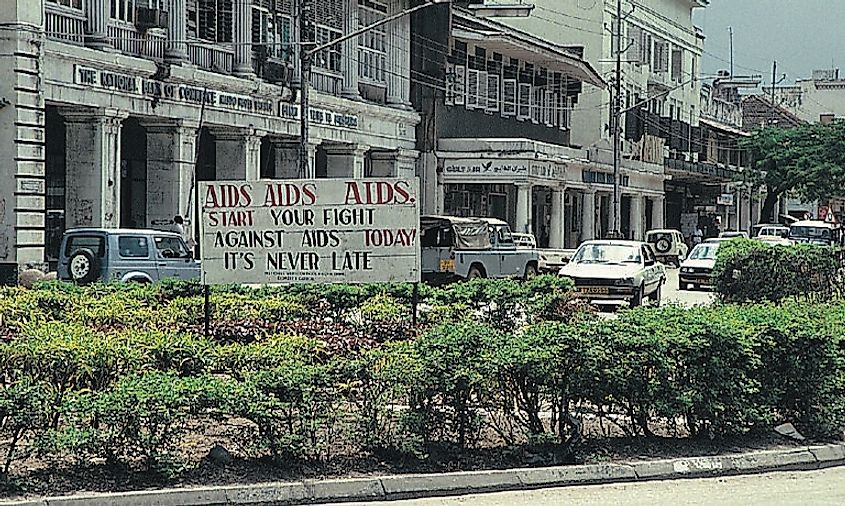Leading Causes Of Death In Tanzania

HIV is the leading cause of death (17%) in Tanzania, followed by lower respiratory infections (11%), and malaria (7%). Infectious diseases are emerging health concerns especially those related to poor sanitation. Non-communicable disease incidence is slowly rising in the country with over 10% of the population dying from diet-related cases. Life expectancy is 56 years, 58 years for females and 53 for males. Only 8% of all births are registered yearly. About 73% of people aged 15+ are literate, and 75% of the population lives in rural Tanzania with 57.8% of the population living under the poverty line.
HIV/AIDS
HIV in Tanzania accounts for 5% of the deaths in the country. Around 1.4 million people live with HIV in Tanzania. 50,000 new infection cases are reported annually, and 53% of adults are on antiretroviral treatment. The prevalence is higher in females (7%) and males, (5%). About 53.3% of the male population engages in high-risk sexual behavior and does not use any condom during sex. Gender inequality is the leading cause of high infection rates among women. The female population is unable to negotiate for safer sex with their male counterparts. Besides, women are infected earlier in life because they have older partners and get married earlier. The concept of sugar daddy is still widespread in Tanzania. Zanzibar prime location along drug routes is another cause of the high prevalence and incidence rates of HIV. About 35%-42% of people who inject drugs are infected with the virus with females being at greater risk of contracting HIV. In the last decade, Tanzania has increased efforts to get more people to test for HIV. The numbers of testing sites are available all over the country with 90% knowing where to get an HIV test.
Malaria
Malaria has caused a serious public health problem in mainland Tanzania. It is the leading cause of death in children below five years. Malaria is responsible for 36% of all deaths in children. Zanzibar indicates a decline in malaria incidence after the introduction of Long Lasting Insecticide Nets to people in endemic areas. The spread of indoor residual spraying has also contributed to the reduced cases of malaria in the Island of Zanzibar. Like other tropical countries, Tanzania geographical position puts it in malaria endemic region.
TB
By 2013, 65,000 people had contracted TB in Tanzania compared to 11000 in 1984. Dar Es Salaam has the highest incidence rate with 13,983 people making 22% of the population. WHO ranks Tanzania number 15 among 22 countries with the largest number of TB cases. The increased prevalence of HIV in the country is the primary cause of high TB incidence rates. WHO indicate that TB is a high burden disease in the country.
Non-Communicable Diseases
In recent years deaths from NCDs have been alarmingly rising. Deaths from cancer, diabetes, cardiovascular diseases, and road deaths are perceived to be on the rise. Poor sanitation and shortage to safe drinking water are the key contributing factors among children dying from NCDs. Malnutrition is common in the country because 58% of the population lives above the poverty line. Currently, 6% of all deaths are caused by diarrheal diseases, 5% from cancer, 3% from Ischemic Heart Disease and another 3% stroke.
STDs
Zanzibar is a gateway to the African continent and people on the island are at a greater risk of suffering from Sexually Transmitted Diseases than those in mainland Tanzania. 3% of the population in the country dies from STDs. The number is likely to be high in drug injecting people due to the tendency of addicts to have multiple sexual partners, needle sharing, “flash-blood” practices and increased unprotected sex. These factors also predispose victims to HIV.
Tanzania has one of the worst doctor-patient ratios in the world. WHO estimates that 0.0031 physicians were available per 10,000 patients in 2013. The situation is worse in rural Tanzania with only nurses available in the health facilities. 40% of all doctors in the country work in the private sector while the rest are in urban hospitals.
Leading Causes Of Death In Tanzania
| Rank | Cause of Death | % Of Total Deaths |
|---|---|---|
| 1 | HIV | 17% |
| 2 | Lower Respiratory Infections | 11% |
| 3 | Malaria | 7% |
| 4 | Diarrheal Diseases | 6% |
| 5 | Tuberculosis | 5% |
| 6 | Cancer | 5% |
| 7 | Ischemic Heart Disease | 3% |
| 8 | Stroke | 3% |
| 9 | STDs | 3% |
| 10 | Sepsis | 2% |











